VS2 Diamond Clarity Rating Guide [With Videos & Images]
Breathtaking engagement rings with VS2 clarity center stones from White Flash.
I love the VS2 clarity grades when it comes to purchasing diamonds. Why? Put simply, they are a safe purchase in terms of clarity and offer superb value for money.
VS2 diamonds represent a Goldilocks zone where inclusions can’t be seen with the naked eyes and they don’t come with a hefty price tag like their internally flawless or VVS counterparts.
In this guide, you will see real life examples of how a VS2 diamond would look like and discover the insights to shopping for eyeclean diamonds. Let’s dive in!
First of All, What Does VS2 Diamond Clarity Mean?
The term VS is an abbreviation for Very Slightly Included. A VS2 clarity grade is defined as having minor inclusions that can range from difficult to somewhat easy to see by a trained professional using 10X magnification.
Without using any magnification aids, you shouldn’t be able to see any flaws or inclusions with your naked eye in the majority of VS2 diamonds.
Below are two examples of VS2 diamonds that have minute inclusions visible only under magnification. I want you to click on both of them and interact with the videos to get a better idea of what they look like.
When shopping for diamonds, I know that many consumers have questions about a diamond’s clarity. That’s why we curated a list of the best retailers who offer in-depth videos/real photographs to help you make smarter decisions. Check out the list here!
What Are the Differences Between VS1 & VS2 Diamonds?
The differences between a VS2 and a VS1 diamonds are subtle and very technical. You see, when clarity grading is performed, a number of factors go into deciding which grade a diamond falls into.
In essence, it boils down to the severity of the inclusions and how easily they can be seen under magnification. Generally speaking, the inclusions found in VS2 stones are relatively bigger or in larger quantities than those found in VS1 diamonds.
The location of the flaws also plays a role in the grading process. For example, a cloud inclusion found directly under the table facet is much more noticeable than one that is closer to the edge or buried deep within the diamond’s body.
In reality, it is extremely difficult to tell a VS2 apart from a VS1 diamond without a 10X loupe. Here’s a video comparison to show you how they look like in real life.
From an expert’s perspective, there are no discernible clarity differences between these two engagement rings. In fact, both diamonds display incredible sparkle and look equally stunning.
If you are interested in the engagement rings above, click here to see complete details of the 4 prong solitaire setting and 6 prong solitaire setting. You can also click the respective links to view the full video listings of the VS1 diamond and VS2 diamond too.
So, Can You Go Wrong If You Blindly Buy Within This Grade?
While VS2 diamonds are usually eyeclean, there do exist outliers that aren’t and may contain inclusions that are visible to the naked eye. From experience, these outliers are usually larger in carat size (>2ct) or had barely made it past the SI1 grade.
Reading a lab report will only tell you the clarity grade but it won’t tell you whether the diamond is eyeclean. This is why I always stress the importance of magnified photographs/videos and never buying blind.
[subject]Examples of Undesirable Diamonds in the VS2 Grade[/heading]
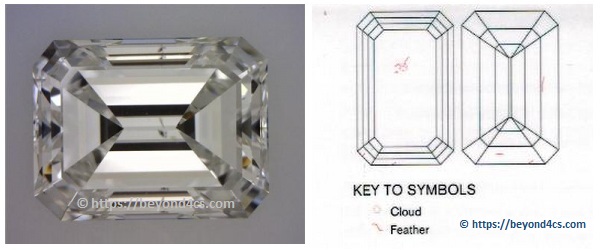
Inclusion plot from GIA report shows a concentration of clouds in the same vicinity.
As you can see above, an eye clean diamond isn’t always guaranteed. Having an eye clean diamond is largely dependent on a few factors: color of the inclusions, cut quality (better light performance helps conceal imperfections) as well as the nature of the flaws.
Here’s another questionable example of a princess cut graded with Very Slightly included clarity. This inclusion may be visible to your naked eye depending on the type of lighting conditions you are in and also the orientation of your eyes to the diamond.
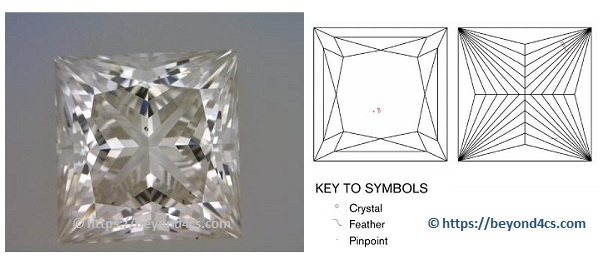
Princess cut with dark crystal inclusions under table facet.
Step Cuts Usually Require More Attention to Clarity Details
With step cuts, it is always prudent to check the diamond with a loupe before you make any purchase. This asscher cut is an example of a stone that you want to avoid due to its prominent crystal inclusion under the table facet.
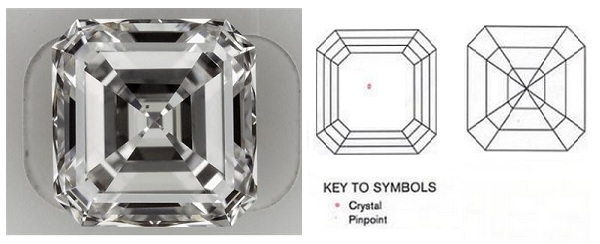
Under the table facet, it is wise to avoid diamonds with big, dark crystal inclusions.
The Bottomline: Is VS2 Clarity Good?
At this point, if you are worried about buying a diamond in the VS2 clarity grade, don’t be. What I had shown you above are exceptions that you don’t normally see. The sole purpose of showing these examples is to highlight the need for better awareness and verification of details.
The fact is, the majority of VS2 diamonds are eyeclean and will have inclusions that look like the examples listed below.
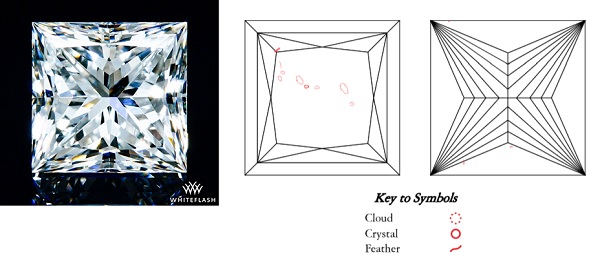
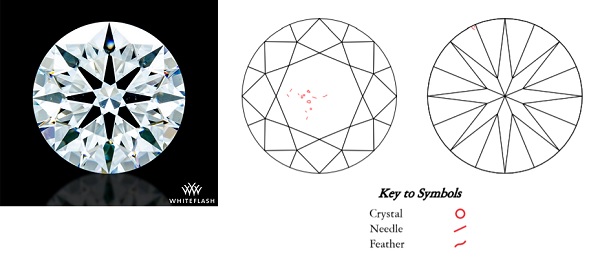
Click these links to view the stones under magnification: princess cut & round cut.
VS2 diamonds offer good quality for budget-friendly prices and they are usually eyeclean. When making a selection, it’s important to view photographs or videos under magnification to see exactly how the diamond looks like.
And when you shop smart at the right places, you can get a beautiful diamond ring that looks fantastic without breaking the bank.
I recommend working with vendors like White Flash.com and JamesAllen.com. Both of these vendors are very reliable and provide tangible data in their listings. Having information like videos will reveal the diamond’s appearance in real life and eliminate second guessing. Click here to start browsing VS2 diamonds and experience online shopping like never before…
Related Articles
Share This Page on Social Media!






